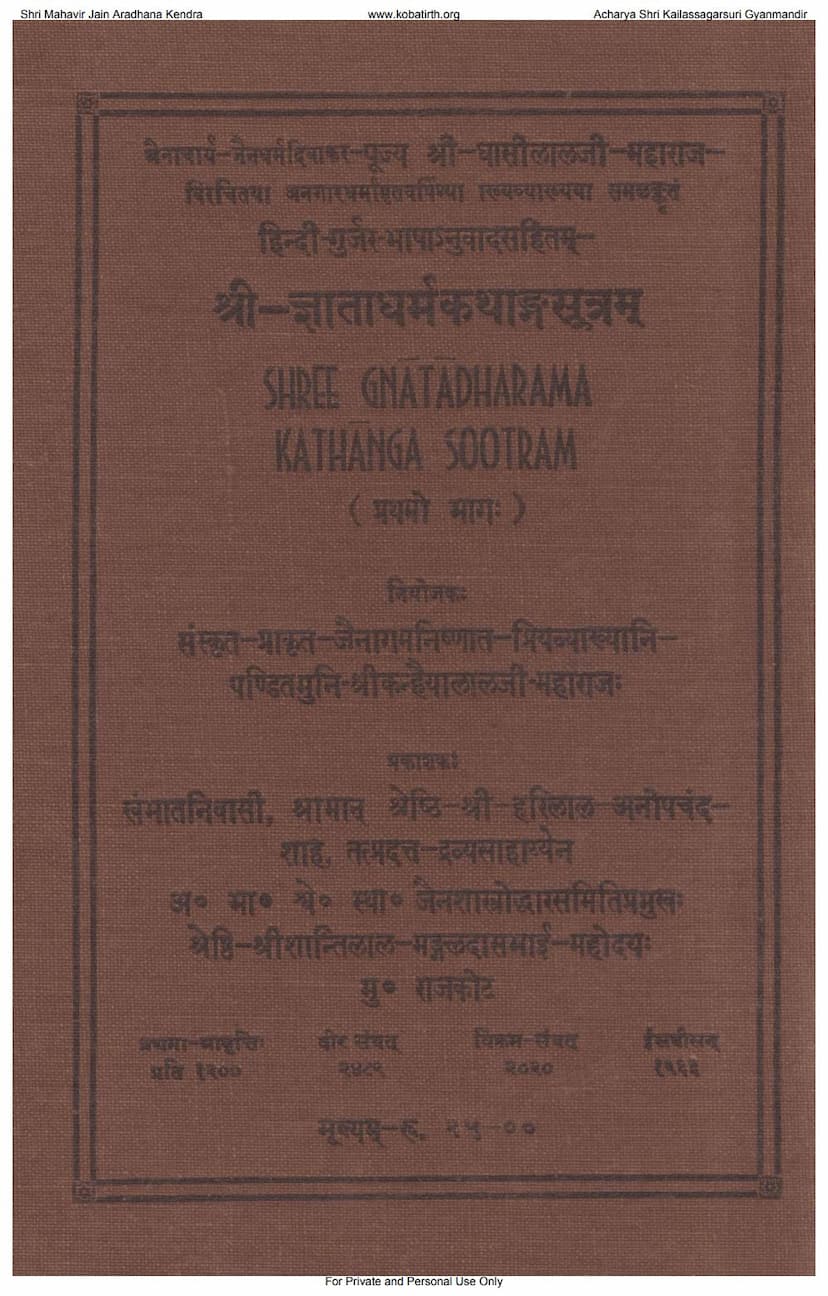Gnatadharmkathanga Sutram Part 01
Added to library: September 1, 2025

Summary
Here is a comprehensive summary of the provided Jain text, "Gnatadharmkathanga Sutram Part 01," based on the content you've shared:
Book Title: Gnatadharmkathanga Sutram Part 01 Author: Kanhaiyalalji Maharaj Publisher: A B Shwetambar Sthanakwasi Jain Shastroddhar Samiti Catalog Link: https://jainqq.org/explore/020352/1
This volume, "Shree Gnatadharmakathanga Sutram Part 01," is presented with commentary titled "Angaradharmamritavarshini" by Acharya Shri Ghasilalji Maharaj, and includes Hindi and Gujarati translations. It is dedicated to Acharya Shri Kailassagarsuri Gyanmandir.
The text is structured into studies (Adhyayana), and this first volume covers the First, Second, Third, and Fourth Studies.
Key Themes and Content Summary:
The core purpose of the Gnatadharmakathanga Sutram, as explained in the commentary, is to be part of the Dharma Kathaanuyoga, one of the four essential "Anuyogas" (streams of religious literature) within the vast Jain Agam. The Dharma Kathaanuyoga focuses on religious narratives and teachings through stories. The Gnatadharmakathanga Sutram specifically aims to elucidate the meaning of key terms and concepts within this category, making the essence of Dharma accessible, especially to those with less intellectual capacity.
The text begins with:
- Mangalacharan (Page 13): A prayerful salutation to the Siddhas (liberated souls), acknowledging their state of perfect knowledge, purity, and eternal abode.
- Author's Intent (Page 14-15): The author, Pandit Muni Shri Kanhaiyalalji Maharaj, expresses his humble intention to present this commentary for the benefit of all beings, especially those seeking to understand the Dharma, by explaining the meaning of terms within the text. He highlights the significance of the Gnatadharmakathanga Sutram as a source of Dharma knowledge, being part of the eleven Angas of Jain scriptures that focus on religious narratives.
- Introduction to Jain Agam (Page 15-16): The Jain Agam is described as an unfathomable ocean, navigated by four Anuyogas: Charana Karananuyoga, Dharma Kathaanuyoga, Ganitanuyoga, and Dravyanuyoga. The Gnatadharmakathanga Sutram falls under Dharma Kathaanuyoga. The importance of understanding individual words (Pada Bodha) to grasp the meaning of a sentence is emphasized. Dharma is defined as that which prevents beings from falling into lower realms (Durgati) and guides them towards the higher realms (Sugati), exemplified by principles like non-violence.
Detailed Breakdown of Studies and Key Narratives (based on the page numbers and index):
-
First Study (Pages 5-530):
- Chapters 1-2 (Pages 1-4): Introduction and Mangalacharan.
- Mangalacharan
- Avataranika (Introduction)
- Description of Champanagari and surrounding areas.
- Sudharma Swami's arrival in Champanagari for Samavasarana.
- Question-answer session between Sudharma Swami and Abhayakumar.
- Narrative of Abhayakumar's life.
- Description of Dharani Devi.
- Description of Dharani Devi's dream.
- Interpretation of the dream's outcome.
- Measures to protect against the dream's potential negative effects.
- Preparation of the Upasthanashala (Assembly Hall).
- Question-answer session regarding the dream.
- Akalmegh's (a character) fulfillment of desires (Dohad).
- Meghkumar's birth.
- Meghkumar's upbringing and subsequent life.
- Description of Shraman Bhagwan Mahavir's Samavasarana.
- Meghkumar's encounter with Bhagavan Mahavir.
- Meghkumar's dialogue with his parents.
- Meghkumar's initiation ceremony (Dikshotava).
- Meghkumar's (now Meghmuni) meditation (Artadhyan).
- Meghmuni's observance of Hasti-brahma (a severe penance).
- Bhagavan's sermon to Meghmuni.
- Meghmuni's acceptance of penance and vows.
- Description of Meghmuni's austere body.
- Meghmuni's contemplation of Samlekhana (spiritual preparation for death).
- Meghmuni's acceptance of Samlekhana.
- Meghmuni's spiritual journey (Gati).
- Statement of rebuke (Upalambha).
-
Second Study (Pages 566-670): 29. Description of the dilapidated state of Rajagriha's garden. 30. Description of Bhadra, the wife. 31. Narrative of Vijay, the robber. 32. Bhadra Sarthavahi's thoughts. 33. Bhadra Sarthavahi's desires (Dohad). 34. Devdutta Dasachetaka's description. 35. Dhanya Seth's confrontation and entanglement with Vijay the thief. 36. Dhanya Seth's attainment of Moksha. 37. Bhagavan's sermon to the ascetics.
-
Third Study (Pages 672-720): 38. Introduction to the third study. 39. Description of a peacock's egg. 40. Narratives of Vijayadatta and Sagardatta.
-
Fourth Study (Pages 721-749): 41. The story of the tortoise and the jackals regarding sensory control (Guptendriya).
Additional Content:
- Biographical Sketch of Seth Shri Harilal Anopchand Shah (Pages 6-7): This section provides a detailed account of Seth Shri Harilal Anopchand Shah of Khambhat, highlighting his contributions to society, his business acumen, his active participation in the freedom movement, his philanthropic work in establishing hospitals, his devotion to Jain monks and nuns, and his commitment to religious practices. It mentions his personal acceptance of lifelong celibacy along with his wife, which was instrumental in extending the stay of a revered Mahasati. His unfortunate passing at the age of 65 is also noted, along with his legacy and the continuation of his religious values by his children.
- Photographs of Revered Personalities (Pages 8-13): These pages feature photographs of various respected individuals, possibly patrons or key figures associated with the publication or the Jain community.
Overall Purpose:
The "Gnatadharmakathanga Sutram Part 01," through its narratives and detailed commentary, serves as a didactic text within Jainism. It uses stories to impart moral lessons, explain religious principles, and guide individuals towards spiritual upliftment and liberation. The detailed descriptions of characters, events, and the cosmological elements reflect the richness and depth of Jain tradition. The emphasis on the life of Meghkumar in the initial chapters, his transformation through spiritual practices, and his eventual renunciation highlights the Jain path of detachment and salvation.